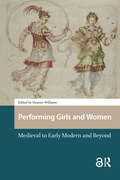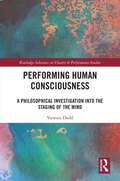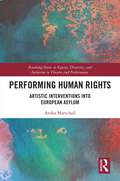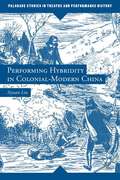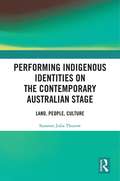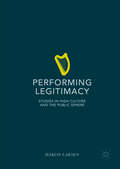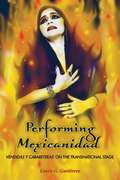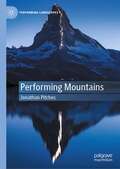- Table View
- List View
Performing Farmscapes (Performing Landscapes)
by Susan C. HaedickeThis book argues that the performance-based work in the featured case studies contributes to the construction of food democracy where the public takes back decision-making in shaping the food system. It explores how contemporary artists translate scientific research about local and global agricultural issues into life stories that inform and engage their audiences and, in so doing, transform passive food consumers into proactive food citizens. The pairing of performing and farmscapes (complex webs of farmlands and storylines) enables artists to use embodied practices to encourage audiences to imagine a just and sustainable agri-food system and to collaborate on making it a reality. The book arranges the case studies on a trajectory that moves from projects that foreground knowledge acquisition to ones that emphasize social engagement by creating conversations and coalitions between farming and nonfarming communities to a final one that pairs protest art and political activism to achieve legally-binding changes in the agricultural landscape.
Performing Fear in Television Production: Practices of an Illiberal Democracy (Asian Visual Cultures)
by Siao Yuong FongWhat goes into the ideological sustenance of an illiberal capitalist democracy? While much of the critical discussion of the media in authoritarian contexts focus on state power, the emphasis on strong states tend to perpetuate misnomers about the media as mere tools of the state and sustain myths about their absolute power. Turning to the lived everyday of media producers in Singapore, this book poses a series of questions that explore what it takes to perpetuate authoritarian resilience in the mass media. How, in what terms and through what means, does a politically stable illiberal Asian state like Singapore formulate its dominant imaginary of social order? What are the television production practices that perform and instantiate the social imaginary, and who are the audiences that are conjured and performed in the process? What are the roles played by imagined audiences in sustaining authoritarian resilience in the media? As argued in the book, if audiences function as the central problematic that engenders anxieties and self-policing amongst producers, can the audience become a surrogate for the authoritarian state?
Performing Feeling in Cultures of Memory
by Bryoni TrezisePerforming Feeling in Cultures of Memory brings memory studies into conversation with a focus on feelings as cultural actors. It charts a series of memory sites that range from canonical museums and memorials, to practices enabled by the virtual terrain of Second Life, popular 'trauma TV' programs and radical theatre practice.
Performing Flight: From the Barnstormers to Space Tourism
by Scott MagelssenPerforming Flight sheds new light on moments in the history of US aviation and spaceflight through the lens of performance studies. From pioneering aviator Bessie Coleman to the emerging industry of space tourism, performance has consistently shaped public perception of the enterprise of flight and has guaranteed its success as a mode of entertainment, travel, research, and warfare. The book reveals fundamental connections between performance and human aviation and space travel over the past 100 years, beginning with the early aerial entertainers known as barnstormers (named after itinerant 19th century theater troupes) to the performative history of the Enola Gay and its pilot Paul Tibbets, who dropped the bomb on Hiroshima, thus ushering in the atomic age. The book also explores the phenomenon of “the pilot voice”; the creation of the American Astronaut, on whose performative success the Cold War, the Space Race, and funding of the US Space Program all depended; and the performative strategies employed to cement notions of space tourism as both manifest destiny and an escape route from a failed planet. A final chapter addresses the four hijacked flights of 9/11 and their representations in discourse and in memorials. Performing Flight effectively and imaginatively demonstrates the ways in which performance and flight in the United States have been inextricably linked for more than a century.
Performing Gender and Comedy: Theories, Texts and Contexts
by Hengen SFirst Published in 1998. Routledge is an imprint of Taylor & Francis, an informa company.
Performing Girls and Women: Medieval to Early Modern and Beyond (Gendering the Late Medieval and Early Modern World)
by Deanne WilliamsThis book charts the broad cultural impact of the medieval and early modern female performer: how she engages with her historical origins in classical drama, works within contemporary cultural and professional networks, and sets the terms for female performance in subsequent historical periods. Moving beyond the archival evidence that establishes that medieval and early modern women and girls performed, it explores how their performances resonated across national boundaries and historical periods, revealing wide patterns of influence and inspiration. This collection of original essays brings together well-established authorities with new and emerging scholars, offering innovative and ground-breaking discussions of medieval dramatic cultures, the Shakespearean stage, professional actresses in Spain and Italy, the performance of music and dance, artistic representations of the female performer, and twentieth- and twenty-first-century adaptations. Ranging from tenth-century Germany to twenty-first-century London, the chapters in this volume offer a new set of paradigms for understanding and interpreting women and girls on stage.
Performing Greek Comedy
by Alan HughesAlan Hughes presents a new complete account of production methods in Greek comedy. The book summarizes contemporary research and disputes, on such topics as acting techniques, theater buildings, masks and costumes, music and the chorus. Evidence is re-interpreted and traditional doctrine overthrown. Comedy is presented as the pan-Hellenic, visual art of theater, not as Athenian literature. Recent discoveries in visual evidence are used to stimulate significant historical revisions. The author has directly examined 350 vase scenes of comedy in performance and actor-figurines, in 75 collections, from Melbourne to St Petersburg. Their testimony is applied to acting techniques and costumes, and women's participation in comedy and mime. The chapters are arranged by topic, for convenient reference by scholars and students of theater history, literature, classics and drama. Overall, the book provides a fresh practical insight into this continually developing subject.
Performing Ground
by Laura LevinPerforming Ground explores camouflage as a performance practice, arguing that the act of blending into one's environment is central to the ways we negotiate our identities through space. The book offers a critically rich investigation of how the performative practice of camouflage renders the politics of space, power, and gender (in)visible.
Performing Home (Routledge Advances in Theatre & Performance Studies)
by Stuart AndrewsPerforming Home is the first sustained study of the ways in which artists create artworks in, and in response to, domestic dwellings. In the context of growing interest in ideas and practices that cross between architecture, arts practice and performance, it is valuable to understand what happens when artists make work in and about specific buildings. This is particularly important with domestic dwellings, which can be bound up with experiences, issues, practices and understandings of home. The book focuses on a range of recent artistic projects to identify and investigate critical ways by which artists practise domestic dwellings. In doing so, it addresses the ways in which artists enquire into a dwelling, are resident in a dwelling, adapt the form of a dwelling, practise a mobile dwelling, and make a dwelling. By considering these practices together, Andrews demonstrates the breadth and significance of recent artistic engagement in and with domestic dwellings, and highlights the contribution that artistic practice can make to the ways in which we understand the form and practice of a building. Performing Home will be of particular relevance to scholars, students and practitioners in architecture, art and performance, to those in geography, material culture and cultural studies, and to anyone seeking to make sense of the place in which they live.
Performing Homescapes (Performing Landscapes)
by Sally Mackey Adelina OngPart of the Performing Landscapes series, Performing Homescapes is an edited collection comprising a contemporary exploration of performing many iterations of landscapes of homes. Authors were invited to respond to a detailed brief with home to be deliberately reconsidered as homescape, represented by landscapes, sites and practices often outside, and occasionally including a conventional home-as-house and intimate dwelling. We wanted a diverse range of geographical sites to be represented and a global offer, encompassing a pluriverse of homescapes. Voices, practices, and epistemologies from the Global South and global majority were important to us, including Indigenous ways of knowing and practicing. This curated collection offers an expanded understanding of the performance of home/scapes as a new intervention into the fields of performance and home scholarship. Performing Homescapes moves beyond spatial meditations within rooms of a house to offer an original critical engagement with the social, political, ecological and cultural landscapes that shape and sustain affects related to the notion of home, unhomeliness and, even, solastalgia. While the impact of the social, political and cultural landscapes on relationships with - and within - the house are implied in most academic literature on forms of performing home, it is foregrounded in the chapters of this edited collection. In addition, certain chapters attend to the more-than-human, human relationships with the Earth as homescape and the co-creation of homescapes within and beyond dwellings.
Performing Human Consciousness: A Philosophical Investigation into the Staging of the Mind (ISSN)
by Vanessa DoddIs the mind like a theatrical performance? This comparison has often been used as a conceptual tool by neuroscientists, philosophers, and psychologists in trying to understand what constitutes the human mind, and in particular how the comings and goings and the character transformations on the stage and in the scripted text give us visible access to the hidden workings of the human mind.Performing Human Consciousness makes use of this metaphor to explore the variety of ways in which the private thoughts and feelings we all have bring into play many aspects of persistent philosophical questions over how the essentially private world of personal experiences can relate to and communicate with the common public world. To investigate this generalisation in more detail, the author brings into play her own conscious experiences by making use of an auto-inscribed play Being Me. Through this dramatic medium she seeks to show in detail how phenomenal consciousness is captured through the dramatic play text and thereby made known to others through performance of that text. Broadening out her argument further, the author then embarks on an enquiry into a selection of play texts from an historical variety of perspectives, from the early Greek and Mediaeval dramas, through to the Symbolist period and onwards to the present day, demonstrating the variety of ways in which they illustrate her argument. This book will be of great interest to students and scholars of theatre & performance and scriptwriting.
Performing Human Rights: Artistic Interventions into European Asylum (Routledge Series in Equity, Diversity, and Inclusion in Theatre and Performance)
by Anika MarschallThis book enhances critical perspectives on human rights through the lens of performance studies and argues that contemporary artistic interventions can contribute to our understanding of human rights as a critical and embodied doing. This study is situated in the contemporary discourse of asylum and political art practices. It argues for the need to reimagine human rights as performative and embodied forms of recognition and practical honouring of our shared vulnerability and co-dependency. It contributes to the debate of theatre and migration, by understanding that contemporary asylum issues are complex and context specific, and that they do not only pertain to the refugee, migrant, asylum seeker or stateless person but also to privileged constituencies, institutional structures, forms of organisation and assembly. The book presents a unique mixed-methods approach that focuses equally on performance analyses and on political philosophy, critical legal studies and art history – and thus speaks to a range of politically interested scholars in all four fields.
Performing Hybridity in Colonial-Modern China
by Siyuan LiuIn Shanghai in the early twentieth century, a hybrid theatrical form, wenmingxi, emerged that was based on Western spoken theatre, classical Chinese theatre, and a Japanese hybrid form known as shinpa. This book places it in the context of its hybridized literary and performance elements, giving it a definitive place in modern Chinese theatre.
Performing Ice (Performing Landscapes)
by Elizabeth Leane Matt Delbridge Carolyn PhilpottIn the Anthropocene, icy environments have taken on a new centrality and emotional valency. This book examines the diverse ways in which ice and humans have performed with and alongside each other over the last few centuries, so as to better understand our entangled futures. Icescapes – glaciers, bergs, floes, ice shelves – are places of paradox. Solid and weighty, they are nonetheless always on the move, unstable, untrustworthy, liable to collapse, overturn, or melt. Icescapes have featured – indeed, starred – in conventional theatrical performances since at least the eighteenth century. More recently, the performing arts – site-specific or otherwise – have provoked a different set of considerations of human interactions with these non-human objects, particularly as concerns over anthropogenic warming have mounted. The performances analysed in the book range from the theatrical to the everyday, from the historical to the contemporary, from low-latitude events in interior spaces to embodied encounters with the frozen environment.
Performing Identity: Actor Training, Self-Commodification and Celebrity
by Barry KingThis book examines how the persistent and deepening casualization and precarity of acting work, coupled with market pressures, has affected the ways in which actors are trained in the US and UK. It reviews the existing state of training, looking at various theories of what the actor does, debates about casting, and the impact of reality television and social media. In the increasing effort to find ways to overcome the precarious labour market for actors and other performers, the traditional emphasis on theatrical character has been replaced by the celebration of the persona – a public image of the performer as a personal brand. As a result, a physiocratic elite, that literally incorporates the collective labour of cultural workers into the star or celebrity body, has formed. This book explores how the star or celebrity’s appearance and comportment are positioned as the rule of nature, formed and abiding outside capitalism as a mode of production. This book will be of interest to those studying theatre studies and performance, contemporary stardom and celebrity and the impact of technology on the formation of identity.
Performing Image (The\mit Press Ser.)
by Isobel HarbisonAn examination of how artists have combined performance and moving image for decades, anticipating our changing relation to images in the internet era.In Performing Image, Isobel Harbison examines how artists have combined performance and moving image in their work since the 1960s, and how this work anticipates our changing relations to images since the advent of smart phones and the spread of online prosumerism. Over this period, artists have used a variety of DIY modes of self-imaging and circulation—from home video to social media—suggesting how and why Western subjects might seek alternative platforms for self-expression and self-representation. In the course of her argument, Harbison offers close analyses of works by such artists as Robert Rauschenberg, Yvonne Rainer, Mark Leckey, Wu Tsang, and Martine Syms.Harbison argues that while we produce images, images also produce us—those that we take and share, those that we see and assimilate through mass media and social media, those that we encounter in museums and galleries. Although all the artists she examines express their relation to images uniquely, they also offer a vantage point on today's productive-consumptive image circuits in which billions of us are caught. This unregulated, all-encompassing image performativity, Harbison writes, puts us to work, for free, in the service of global corporate expansion. Harbison offers a three-part interpretive framework for understanding this new proximity to images as it is negotiated by these artworks, a detailed outline of a set of connected practices—and a declaration of the value of art in an economy of attention and a crisis of representation.
Performing Indigenous Identities on the Contemporary Australian Stage: Land, People, Culture
by Susanne Julia ThurowOver the past 50 years, Indigenous Australian theatre practice has emerged as a dynamic site for the discursive reflection of culture and tradition as well as colonial legacies, leveraging the power of storytelling to create and advocate contemporary fluid conceptions of Indigeneity. Performing Indigenous Identities on the Contemporary Australian Stage offers a window into the history and diversity of this vigorous practice. It introduces the reader to cornerstones of Indigenous Australian cultural frameworks and on this backdrop discusses a wealth of plays in light of their responses to contemporary Australian identity politics. The in-depth readings of two landmark theatre productions, Scott Rankin’s Namatjira (2010) and Wesley Enoch & Anita Heiss’ I Am Eora (2012), trace the artists’ engagement with questions of community consolidation and national reconciliation, carefully considering the implications of their propositions for identity work arising from the translation of traditional ontologies into contemporary orientations. The analyses of the dramatic texts are incrementally enriched by a dense reflection of the production and reception contexts of the plays, providing an expanded framework for the critical consideration of contemporary postcolonial theatre practice that allows for a well-founded appreciation of the strengths yet also pointing to the limitations of current representative approaches on the Australian mainstage. This study will be of great interest to students and scholars of Postcolonial, Literary, Performance and Theatre Studies.
Performing Interdisciplinarity: Working Across Disciplinary Boundaries Through an Active Aesthetic
by Experience BryonPerforming Interdisciplinarity proposes new ways of engaging with performance as it crosses, collides with, integrates and/or disturbs other disciplinary concerns. From Activism and Political Philosophy to Cognitive Science and Forensics, each chapter explores the relationships between performance and another discipline. Including cross-chapter discussions which address the intersections between fields, Performing Interdisciplinarity truly examines the making of meaning across disciplinary conventions. This is a volume for performance practitioners and scholars who are living, learning, writing, teaching, making and thinking at the edges of their specialisms.
Performing Kamishibai: An Emerging New Literacy for a Global Audience (Routledge Research in Education)
by Tara McGowanKamishibai (paper-theater), a Japanese picture-storytelling medium, is gaining global interest as we move from a text-based culture to one that emphasizes multiple semiotic systems and performance. This is the first volume to explore the potential of kamishibai as a dynamic "new" interactive medium for teaching multimodal communication and shows how synchronizing oral, visual and gestural modes develops students’ awareness of all modes of communication as potential resources in their learning. By examining the multiple modes involved in kamishibai through actual student performances over several venues, this volume overturns commonly held expectations about literacy in the classroom and provides a critical perspective on assumptions about other media. It offers much-needed information about a medium that is attracting interest from educators, academics and artists worldwide.
Performing Korea
by Patrice PavisThis book offers an exploration of the intersection of Korean theatre practice with Western literary theatre. Gangnam Style, K-Pop, the Korean Wave : who hasn't heard of these recent Korean phenomena? Having spent two years in Korea as a theatrical and cultural 'tourist', Patrice Pavis was granted an unparalleled look at contemporary Korean culture. As well as analyzing these pop culture mainstays, however, he also discovered many uniquely Korean jewels of contemporary art and performance. Examining topics including contemporary dance, puppets, installations, modernized pansori, 'Koreanized' productions of European Classics and K-pop and its parody, this book provides a framework for an intercultural and globalized approach to Korean theatre. With the first three chapters of the book outlining methodology, the remaining chapters test - often deconstructing and transforming in the process - this framework, using focused case studies to introduce the reader to the cultural and artistic world of a nation with an increasing international presence in theatre and the arts alike.
Performing Legitimacy
by Håkon LarsenThis book is an investigation ofthe cultural work involved in the social process of achieving and maintaininglegitimacy as a not-for-profit arts or media organization in the twenty-first century. Within this work, Larsenadvances an approach to studying organizational legitimacy, emanating fromwithin cultural sociology. More specifically, he analyzes the legitimationwork done in public service broadcasters in the Scandinavian countries ofNorway,Sweden, and Denmark, the Norwegian National Opera and Ballet, the OsloPhilharmonic Orchestra, and the Metropolitan Opera in New YorkCity.
Performing Memory in Art and Popular Culture (Routledge Research in Cultural and Media Studies)
by Liedeke Plate Anneke SmelikThis volume pursues a new line of research in cultural memory studies by understanding memory as a performative act in art and popular culture. The authors take their cue from the observation that art and popular culture enact memory and generate processes of memory. They do memory, and in this doing of memory new questions about the cultural dimensions of memory arise: How do art objects and artistic practices perform the past in the present? What is their relationship to the archive? Does the past speak in the performed past (or do we speak to it)? To what purpose do objects "recall"? And for whom do they recollect? Here authors combine a methodological focus on memory as performance with a theoretical focus on art and popular culture as practices of remembrance. The essays in the book thus analyze what is at stake in the complex processes of remembering and forgetting, of recollecting and disremembering, of amnesia and anamnesis, that make up cultural memory.
Performing Mexicanidad: Vendidas y Cabareteras on the Transnational Stage
by Laura G. GutiérrezUsing interdisciplinary performance studies and cultural studies frameworks, Laura G. Gutiérrez examines the cultural representation of queer sexuality in the contemporary cultural production of Mexican female and Chicana performance and visual artists.<P> In particular, she locates the analytical lenses of feminist theory and queer theory in a central position to interrogate Mexican female dissident sexualities in transnational public culture. <P><P> This is the first book-length study to wed performance studies and queer theory in examining the performative/performance work of important contemporary Mexicana and Chicana cultural workers. It proposes that the creations of several important artists—Chicana visual artist Alma López; the Mexican political cabareteras Astrid Hadad, Jesusa Rodríguez, Liliana Felipe, and Regina Orozco; the Chicana performance artist Nao Bustamante; and the Mexican video artist Ximena Cuevas—unsettle heterosexual national culture. In doing so, they are not only challenging heterosexist and nationalist discourses head-on, but are also participating in the construction of a queer world-making project. Treating the notion of dis-comfort as a productive category in these projects advances feminist and queer theories by offering an insightful critical movement suggesting that queer worlds are simultaneously spaces of desire, fear, and hope.
Performing Migrancy and Mobility in Africa
by Mark FleishmanPerforming Migrancy and Mobility in Africa focuses on a body of performance work, the work of Magnet Theatre in particular but also work by other artists in Cape Town and other parts of the continent or the world, that engages with the Cape as a real or imagined node in a complex system of migration and mobility. Located at the foot of the African continent, lodged between two oceans at the intersection of many of the earth's major shipping lanes, Cape Town is a stage for a powerful mixing of cultures and peoples and has been an important node in a network of flows, circuits of movement and exchange. The performance works studied here attempt to get to grips with what it feels like to be on the move and in the spaces in-between that characterises the lives, now and for centuries before, of multiple peoples who move around and pass through places like the Cape. The contributors are a broad range of mostly African authors from various parts of the continent and as such the book offers an insight into new thinking and new approaches from an emerging and important location.
Performing Mountains (Performing Landscapes)
by Jonathan PitchesLaunching the landmark Performing Landscapes series, Performing Mountains brings together for the first time Mountain Studies and Performance Studies in order to examine an international selection of dramatic responses to mountain landscapes. Moving between different registers of writing, the book offers a critical assessment of how the cultural turn in landscape studies interacts with the practices of environmental theatre and performance. Conceived in three main parts, it begins by unpicking the layers of disciplinary complexity in both fields, before surveying the rich history and practice of rituals, playtexts and site specific works inspired by mountains. The last section moves to a unique analysis of mountains themselves using key concepts from performance: training, scenography, acting and spectatorship. Threaded throughout is a very personal tale of mountain research, offering a handrail or alternative guide through the book.





